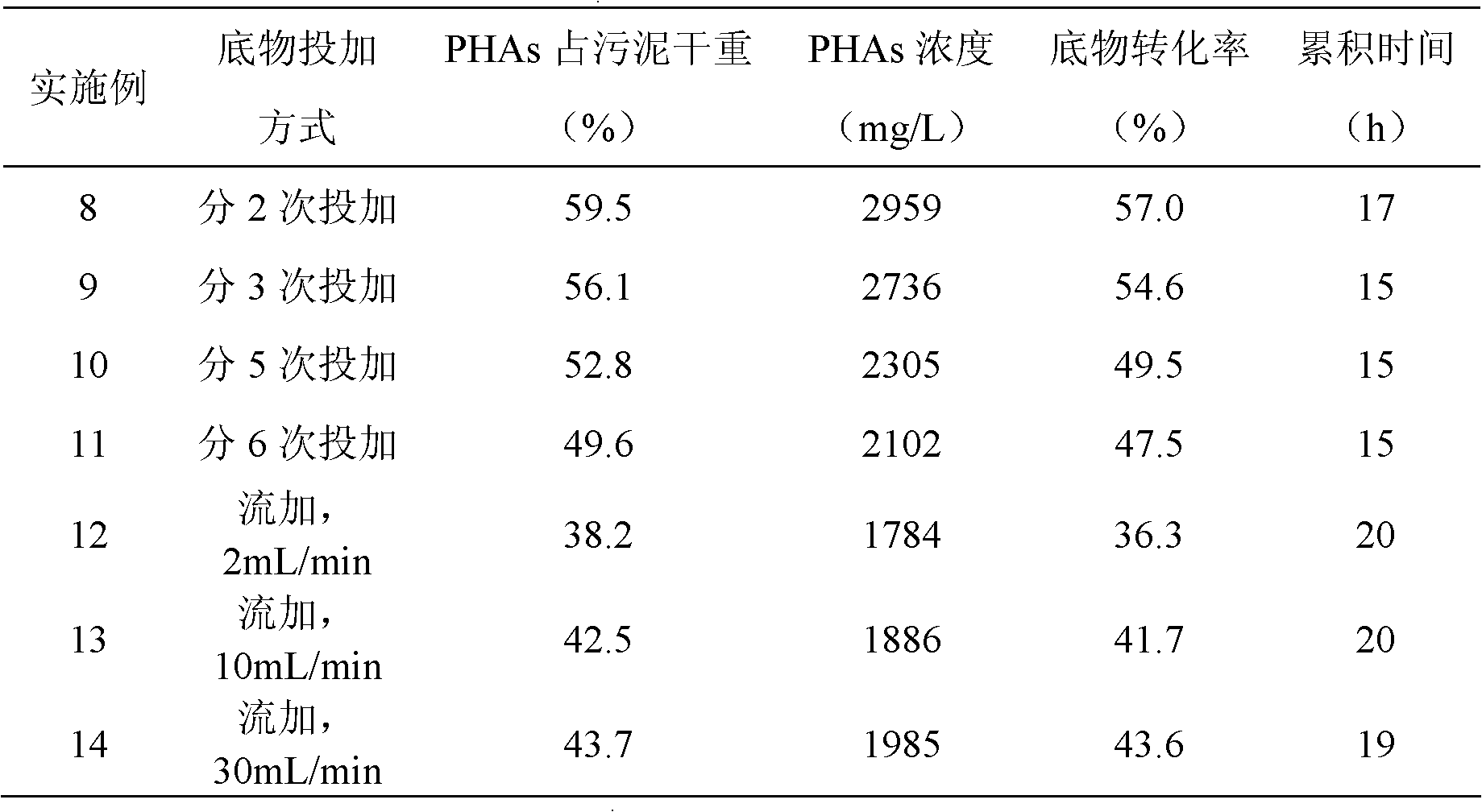Method for synthesizing polyhydroxyalkanoate by using residual sludge broth as substrate
A technology of polyhydroxyalkanoate and excess sludge, which is applied in fermentation, sludge treatment, biological sludge treatment, etc., can solve the problem that the synthesis cost of PHAsPHAs cannot meet the requirements of industrialization.
- Summary
- Abstract
- Description
- Claims
- Application Information
AI Technical Summary
Problems solved by technology
Method used
Image
Examples
Embodiment 1
[0019] (1) Domestication of sludge
[0020] Take 5L of activated sludge with MLSS of 1g / L in the domesticator, add culture medium solution so that the concentration of each component in the sludge system is: CH 3 COOH 0.1mL / L, CH 3 CH 2 COOH 0.7mL / L, KCl 100mg / L, K 2 HPO 4 ·3H 2 O 50mg / L, NH 4 Cl 85mg / L, MgSO 4 70mg / L, CaCl 2 20mg / L, FeCl 3 ·6H 2 O 5mg / L, peptone 110mg / L, yeast extract 30mg / L, adjust the initial pH value to be neutral, and at an aeration rate of 1L / L / min, aerobic aeration for 21h, stop aeration, discharge mud, control The sludge concentration is 1g / L, 3L of supernatant is discharged after 1 hour of precipitation, and after 18 cycles of "water inflow - aerobic aeration - sludge discharge - sedimentation - effluent" cultivation and domestication, the sludge properties are stable, and the appearance changes from gray to black Gradually turns to light brown.
[0021] (2) Anaerobic fermentation of excess sludge to produce VFAs
[0022] Take 1L MLSS with...
Embodiment 2
[0026] (1) Domestication of sludge
[0027] Take 5L of activated sludge with MLSS of 2g / L in the domesticator, add culture medium solution so that the concentration of each component in the sludge system is: CH 3 COOH 0.6mL / L, CH 3 CH 2 COOH 0.2mL / L, KCl 234mg / L, K 2 HPO 4 ·3H 2 O 150mg / L, NH 4 Cl 194mg / L, MgSO 4 150mg / L, CaCl 2 54mg / L, FeCl 3 ·6H 2 O 10mg / L, peptone 334mg / L, yeast extract 124mg / L, adjust the initial pH value to be neutral, and at an aeration rate of 2L / L / min, aerobic aeration for 21h, stop aeration, discharge mud, Control the sludge concentration at 2g / L, discharge 3L of supernatant after 2 hours of precipitation, and then cultivate and domesticate 20 cycles of "water inflow-aerobic aeration-sludge discharge-sedimentation-water effluent", the sludge properties are stable, and the appearance changes from gray to gray Black gradually turns to beige.
[0028] (2) Anaerobic fermentation of excess sludge to produce VFAs
[0029]For VFAs produced by ana...
Embodiment 3
[0033] (1) Domestication of sludge
[0034] The domestication of sludge is shown in Example 2.
[0035] (2) Anaerobic fermentation of excess sludge to produce VFAs
[0036] For VFAs produced by anaerobic fermentation of excess sludge, see Example 1. The difference is that the sludge concentration MLSS used for anaerobic fermentation to produce acid is 30g / L, and the added sodium hydroxide is 1g. Under the conditions of 60°C and magnetic stirring Treat for 60min. After 36 hours of reaction, volatile fatty acids with a concentration of 2.96 g / L were obtained.
[0037] (3) Synthesis of PHAs from sludge
[0038] See Example 1 for the synthesis of PHAs from the sludge. After 10 hours of accumulation, the concentration of PHAs obtained was 1353 mg / L, the PHAs accounted for 36.2% of the dry weight of the sludge, and the substrate conversion rate was 42%.
PUM
 Login to View More
Login to View More Abstract
Description
Claims
Application Information
 Login to View More
Login to View More - R&D
- Intellectual Property
- Life Sciences
- Materials
- Tech Scout
- Unparalleled Data Quality
- Higher Quality Content
- 60% Fewer Hallucinations
Browse by: Latest US Patents, China's latest patents, Technical Efficacy Thesaurus, Application Domain, Technology Topic, Popular Technical Reports.
© 2025 PatSnap. All rights reserved.Legal|Privacy policy|Modern Slavery Act Transparency Statement|Sitemap|About US| Contact US: help@patsnap.com


